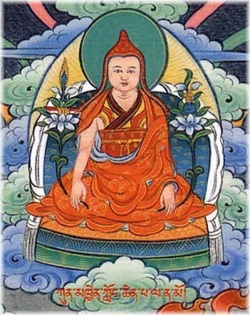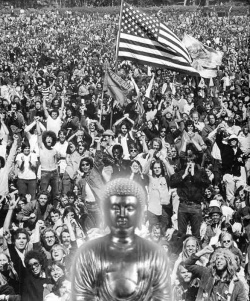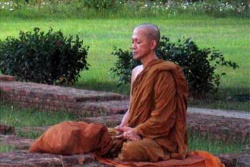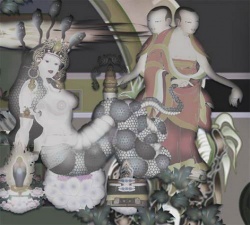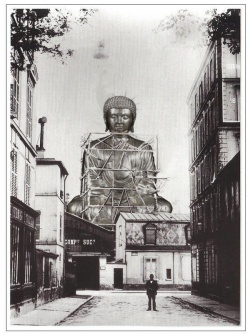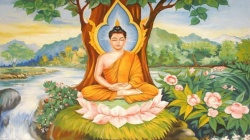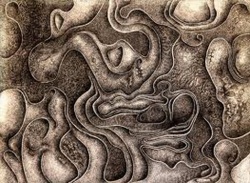Four Noble Truths
RigpaWiki
The Four Noble Truths (Skt. catvāryāryasatyā; Tib. འཕགས་པའི་བདེན་པ་བཞི་, pakpé denpa shyi; Wyl. 'phags pa'i bden pa bzhi) or the Four Realities of the Aryas, were taught by Buddha Shakyamuni as the central theme of the so-called first turning of the wheel of the Dharma after his attainment of enlightenment.
They are:
- the truth (or reality) of suffering (Tib. སྡུག་བསྔལ་གྱི་བདེན་པ་, Skt. duḥkha-satya) which is to be understood,
- the truth (or reality) of the origin of suffering (Tib. ཀུན་འབྱུང་བའི་བདེན་པ་, Skt. samudaya-satya), which is to be abandoned,
- the truth (or reality) of cessation (Tib. འགོག་པའི་བདེན་པ་, Skt. nirodha-satya), which is to be actualized, and
- the truth (or reality) of the path (Tib. ལམ་གྱི་བདེན་པ་, Skt. mārga-satya), which is to be relied upon.[1]
Cause & Effect
The four truths can be divided into two pairs of cause and effect, known as the cause and effect of 'thorough affliction' (Skt. saṃkliṣṭa; Tib. ཀུན་ཉོན་, Wyl. kun nyon) or samsara, and the cause and effect of 'complete purification' (Skt. vyavadāna; Tib. རྣམ་བྱང་, Wyl. rnam byang) or nirvana.
Sixteen Aspects of the Four Noble Truths
Suffering
1. Suffering (Skt. duḥkha)
2. Impermanence (Skt. anitya)
3. Emptiness (Skt. śūnyatā)
4. Selflessness (Skt. anātmaka)
Origination
5. Cause (Skt. hetu)
6. Origination (Skt.samudaya)
7. Intense Arising (Skt. prabhava)
8. Condition (Skt. pratyaya)
Cessation
9. Peace (Skt. śānta)
10. Cessation (Skt. nirodha)
11. Perfection (Skt. praṇīta)
12. True Deliverance or Renunciation (Skt. niḥsaraṇa; Tib. nges 'byung)
Path
13. Path (Skt. mārga)
14. Appropriate (Skt. nyāya)
15. Effective (Skt. pratipatti)
16. Truly Delivering (Skt. nairyāṇika)
Tibetan Texts
![]() W22084 འཕགས་པ་བདེན་པ་བཞིའི་མདོ། bka' 'gyur (sde dge par phud) edition, Vol. 72. ff.170r.-170v. (pp.339-340)
W22084 འཕགས་པ་བདེན་པ་བཞིའི་མདོ། bka' 'gyur (sde dge par phud) edition, Vol. 72. ff.170r.-170v. (pp.339-340)
Further Reading
- Chögyam Trungpa, The Truth of Suffering and the Path of Liberation (Shambhala, 2009)
- The Dalai Lama, His Holiness, Buddha Heart, Buddha Mind: Living the Four Noble Truths (The Crossroad Publishing Company, 2000)
- The Dalai Lama, The Four Noble Truths (Thorsons, 1998)
- The Dalai Lama, Kindness, Clarity and Insight (Snow Lion Publications, 2006), pages 29-34
- The Dalai Lama, Lighting the Way (Snow Lion Publications, 2004), Chapter 1
- The Dalai Lama, The Middle Way (Wisdom Publications)
- Geshe Tashi Tsering, The Four Noble Truths (Wisdom, 2005)
- Jamgön Mipham Rinpoche, Gateway to Knowledge, VOL II (Hong Kong, Boudhanath & Esby: Rangjung Yeshe Publications, 2000)
- Jamyang Drakpa, 'Appendix 2' of The Light of Wisdom, Volume 1 (Rangjung Yeshe Publications, 1999)
- Kangyur Rinpoche, Treasury of Precious Qualities (Boston & London: Shambhala, 2001), pages 67-84 & 'Appendix 3'.
- Mingyur Rinpoche, Joyful Wisdom (Harmony Books, April 2009)
- Ringu Tulku, Daring Steps Towards Fearlessness: The Three Vehicles of Buddhism (Snow Lion, 2005), pages 22-55
- Samdhong Rinpoche, Uncompromising Truth for a Compromised World, (World Wisdom, 2006), pages 182-188
- Thich Nhat Hanh, The Heart of the Buddha's Teaching (Broadway Books, 1999)
- Thrangu Rinpoche, The Venerable Khenchen, The Life of the Buddha and the Four Noble Truths (Namo Buddha Publications, Boulder 2001), Ch 2. Available here
- Walpola Rahula, What the Buddha Taught (Grove Press, Revised ed. 1974)
Footnotes
- ↑ ནད་ནི་ཤེས་བྱ་ནད་ཀྱི་རྒྱུ་ནི་སྤང་བྱ་ལ། །
བདེ་གནས་ཐོབ་བྱ་སྨན་ནི་བསྟེན་པར་བྱ་བ་ལྟར། །
ཤེས་བྱ་སྤང་བྱ་རིག་པར་བྱ་ཞིང་བསྟེན་པར་བྱ། །
སྡུག་བསྔལ་རྒྱུ་དང་དེ་འགོག་པ་དང་དེ་བཞིན་ལམ། །
Illness must be understood, its causes eliminated,
Wellbeing must be attained, and medicine taken.
Likewise, suffering, its causes, their cessation and the path
Must in turn be understood, eliminated, realized and relied upon.
- Maitreya, Sublime Continuum, IV, 55
External Links
- A Brief Overview of the Three Turnings and the Mantra Pitaka of the Vidyadharas by Khenpo Pema Vajra
- Teachings from His Holiness the Dalai Lama
Source
sgilibrary.org
Four noble truths [四諦・四聖諦] (Skt chatur-arya-satya; Jpn shi-tai or shi-shotai )
- A fundamental doctrine of Buddhism clarifying the cause of suffering and the way of emancipation.
The four noble truths are the truth of suffering, the truth of the origin of suffering, the truth of the cessation of suffering, and the truth of the path to the cessation of suffering. Shakyamuni is said to have expounded the four noble truths at Deer Park in Varanasi, India, during his first sermon after attaining enlightenment.
They are:
(1) all existence is suffering; (2) suffering is caused by selfish craving; (3) the eradication of selfish craving brings about the cessation of suffering and enables one to attain nirvana; and (4) there is a path by which this eradication can be achieved, namely, the discipline of the eightfold path.
The eightfold path consists of
right views, right thinking, right speech, right action, right way of life, right endeavor, right mindfulness, and right meditation.
Source
Wikipedia
The Four Noble Truths (Sanskrit: catvāri āryasatyāni; Pali: cattāri ariyasaccāni) are one of the central teachings of the Buddhist tradition.
The teachings on The Four Noble Truths explvain the nature of Dukkha (Pali; commonly translated as "Suffering", "anxiety", "stress", "unsatisfactoriness"), its causes, and how it can be overcome.
According to the Buddhist tradition, The Buddha first taught The Four Noble Truths in the very first teaching he gave after he attained Enlightenment, as recorded in the discourse Setting in Motion the Wheel of the Dharma (Dharmacakra Pravartana Sūtra), and he further clarified their meaning in many subsequent teachings.
Introduction
The teachings on The Four Noble Truths explain the nature of Dukkha (Pali; loosely translated as Suffering, anxiety, dissatisfaction), its causes, and how it can be overcome.
The Four Noble Truths are regarded as central to the teachings of Buddhism; they are said to provide a unifying theme, or conceptual framework, for all of Buddhist Thought.
In the Buddhist tradition, it is said that The Buddha compared these four truths to the footprints of an elephant:
just as the footprints of all the other Animals can fit within the footprint of an elephant, in the same way, all of the teachings of The Buddha are contained within the teachings on The Four Noble Truths.
According to tradition, The Buddha taught on The Four Noble Truths repeatedly throughout his lifetime, continually expanding and clarifying his meaning. Walpola Rahula explains:
- The Heart of The Buddha's teaching lies in The Four Noble Truths (Cattāri Ariyasaccāni) which he expounded in his very first sermon to his old colleagues, the Five ascetics, at Isipatana (modern Sarnath) near Benares.
In this sermon, as we have it in the original texts, these four Truths are given briefly.
But there are innumerable places in the early Buddhist scriptures where they are explained again and again, with greater detail and in different ways.
If we study The Four Noble Truths with the help of these references and explanations, we get a fairly good and accurate account of the essential teachings of The Buddha according to the original texts.
Within The Buddha's first discourse
The four truths are presented within The Buddha's first discourse, Setting in Motion the Wheel of the Dharma (Dharmacakra Pravartana Sūtra). An English translation is as follows:
- "This is the Noble Truth of Dukkha: birth is Dukkha, aging is Dukkha, illness is Dukkha, Death is Dukkha; sorrow, lamentation, pain, Grief and despair are Dukkha; union with what is displeasing is Dukkha; separation from what is pleasing is Dukkha; not to get what one wants is Dukkha; in brief, The five aggregates subject to clinging are Dukkha."
- "This is the Noble Truth of the origin of Dukkha: it is this Craving which leads to renewed existence, accompanied by delight and lust, seeking delight here and there, that is, Craving for sensual pleasures, Craving for existence, Craving for extermination."
- "This is the Noble Truth of the cessation of Dukkha: it is the remainderless fading away and cessation of that same Craving, the giving up and relinquishing of it, freedom from it, nonreliance on it."
3 "This is the Noble Truth of the way leading to the cessation of Dukkha: it is the Noble Eightfold Path; that is,
Right View, right intention, right speech, Right Action, Right livelihood, Right effort, right Mindfulness and Right concentration."
Translation of Pali terms
The Pali wordings of The Four Noble Truths can be translated as:
- Dukkha - "uneasy"; "unsteady, disquieted"; unsatisfactoriness.
- Dukkha Samudaya - "arising", "coming to existence"; the origination of Dukkha.
- Dukkha Nirodha - to confine, release; "control or restraint"; the cessation of Dukkha.
- Dukkha Nirodha Gamini Patipada - Gamini: leading to, making for - Patipada: road, Path, way; the means of reaching a goal or destination - The way of practice leading to the cessation of Dukkha.
The Pali terms Ariya Sacca(Sanskrit: Arya satya) are commonly translated as "Noble truths". Arya means "Noble", "not ordinary"; Sacca means "Truth" or "reality".
Explanation
Summary
The Four Noble Truths can be summarized as follows:
- The Truth of Dukkha (Suffering, anxiety, stress)
- The Truth of the origin of Dukkha
- The Truth of the cessation of Dukkha
- The Truth of the Path leading to the cessation of Dukkha
First Truth: Dukkha
- See also: Dukkha
the first noble truth is the Truth of Dukkha. The Pali term Dukkha (Sanskrit: duhkha) is typically translated as "Suffering", but the term Dukkha has a much broader meaning than the typical use of the word "Suffering".
Dukkha suggests a basic unsatisfactoriness pervading all forms of Life, due to the fact that all forms of Life are Impermanent and constantly changing.
Dukkha indicates a lack of satisfaction, a sense that things never measure up to our expectations or standards.
The emphasis on Dukkha is not intended to be pessimistic, but rather to identify the nature of Dukkha, in order that Dukkha things may be overcome.
The Buddha acknowledged that there is both Happiness and sorrow in the World, but he taught that even when we have some kind of Happiness, it is not permanent; it is subject to change.
And due to this unstable, Impermanent nature of all things, everything we experience is said to have the quality of duhkha or unsatisfactoriness.
Therefore unless we can gain Insight into that Truth, and understand what is really able to give us Happiness, and what is unable to provide Happiness, the experience of dissatisfaction will persist.
Traleg Kyabgon explains:
- Normally we think our Happiness is contingent upon external circumstances and situations, rather than upon our own inner attitude toward things, or toward Life in general.
The Buddha was saying that dissatisfaction is part of Life, even if we are seeking Happiness and even if we manage to find temporary Happiness.
The very fact that it is temporary means that sooner or later the Happiness is going to pass.
So The Buddha said that unless we understand this and see how pervasive dissatisfaction or duhkha is, it is impossible for us to start looking for real Happiness.
Second Truth: origin of Dukkha
- See also: Samudaya
THE SECOND NOBLE TRUTH is the Truth of the origin of Dukkha. Within the context of The Four Noble Truths, the origin (Pali: samudaya) of Dukkha is commonly explained as Craving (Pali: Tanha) conditioned by Ignorance (Pali: Avijja).
This Craving runs on three channels:
- Craving for sense-pleasures (Kama-Tanha): this is Craving for sense objects which provide pleasant Feeling, or Craving for sensory pleasures.
- Craving to be (Bhava-Tanha): this is Craving to be something, to unite with an experience. This includes Craving to be solid and ongoing, to be a being that has a past and a future, and Craving to prevail and dominate over others.
- Craving not to be (vibhava-Tanha): this is Craving to not experience the World, and to be nothing; a wish to be separated from painful feelings.
Ignorance (Pali: Avijja) can be defined as Ignorance of the meaning and implication of The Four Noble Truths.
On a deeper level, it refers to a misunderstanding of the nature of the self and reality.
Another common explanation presents the cause of Dukkha as disturbing emotions (Sanskrit: Kleshas) rooted in Ignorance (Sanskrit: Avidya).
In this context, it is common to identify three root disturbing emotions, called the Three poisons, as the root cause of Suffering or Dukkha. These Three poisons are:
- Ignorance (Sanskrit: Avidya or Moha): misunderstanding of the nature of reality; bewilderment.
- Attachment (Sanskrit: Raga): Attachment to pleasurable experiences.
- Aversion (Sanskrit: Dvesha): a fear of getting what we don't want, or not getting what we do want.
Third Truth: cessation of Dukkha
- See also:Nirodha
THE THIRD NOBLE TRUTH is the Truth of the cessation of Dukkha. Cessation (Pali: Nirodha) refers to the cessation of Suffering and the causes of Suffering. It is
- the cessation of all the unsatisfactory experiences and their causes in such a way that they can no longer occur again.
It's the removal, the final absence, the cessation of those things, their non-arising."
Cessation is the goal of one's Spiritual practice in the Buddhist tradition.
According to the Buddhist point of view, once we have developed a genuine understanding of the causes of Suffering, such as Craving (Tanha) and Ignorance (Avijja), then we can completely eradicate these causes and thus be free from Suffering.
Cessation is often equated with Nirvana (Sanskrit; Pali Nibbana), which can be described as the state of being in cessation or the event or process of the cessation.
A temporary state of Nirvana can be said to occur whenever the causes of Suffering (e.g. Craving) have ceased in our Mind.
Joseph Goldstein explains:
- Ajahn Buddhadasa, a well-known Thai master of the last century, said that when village people in India were cooking rice and waiting for it to cool, they might remark, "Wait a little for the rice to become Nibbana".
So here, Nibbana means the cool state of Mind, free from the fires of the Defilements.
As Ajahn Buddhadasa remarked, "The cooler the Mind, the more Nibbana in that moment". We can notice for ourselves relative states of coolness in our own minds as we go through the day.
Fourth Truth: Path to the cessation of Dukkha
- See also: Noble Eightfold Path
The fourth Noble Truth is the Path to the cessation of Dukkha.
This Path is called the Noble Eightfold Path, and it is considered to be the essence of Buddhist practice.
The Eightfold Path consists of:
Right understanding, Right Thought, Right Speech, Right Action, Right livelihood, Right effort, Right Mindfulness, and Right concentration.
While the first three truths are primarily concerned with understanding the nature of Dukkha (Suffering, anxiety, stress) and its causes,
The Fourth Truth presents a practical method for overcoming Dukkha.
The Path consists of a set of eight interconnected factors or conditions, that when developed together, lead to the cessation of Dukkha. Ajahn Sucitto describes the Path as "a Mandala of interconnected factors that support and moderate each other."
Thus, the eight items of the Path are not to be understood as stages, in which each stage is completed before moving on to the next.
Rather, they are to be understood as eight significant dimensions of one's behaviour—Mental, spoken, and bodily—that operate in dependence on one another; taken together, they define a complete Path, or way of living.
Experiential Knowledge
The term "Noble truths" is a common translation of the Pali terms Ariya Sacca (Sanskrit: Arya satya).
The Pali term Sacca (Sanskrit: satya) means "Truth" and "real" or "actual thing.
" With that in Mind, Rupert Gethin explains that The Four Noble Truths are not asserted as propositional truths or creeds.
Instead, they are understood in the Buddhist tradition as "true things" or "realities" that The Buddha experienced. Gethin writes:
- The word satya (Pali Sacca) can certainly mean Truth, but it might equally be rendered as 'real' or 'actual thing'.
That is, we are not dealing here with propositional truths with which we must either agree or disagree, but with four 'true things' or 'realities' whose nature, we are told, The Buddha finally understood on the night of his Awakening. [...]
This is not to say that The Buddha's discourses do not contain theoretical statements of the nature of Suffering, its cause, its cessation, and the Path to its cessation, but these descriptions function not so much as dogmas of the Buddhist Faith as a convenient conceptual framework for making sense of Buddhist Thought.
This understanding is reflected by Thanissaro Bhikkhu, who states that The Four Noble Truths are best understood not as beliefs, but as categories of experience. Thanissaro Bhikkhu writes:
- These four truths are best understood, not as beliefs, but as categories of experience.
They offer an alternative to the ordinary way we categorize what we can know and describe–in terms of me/not me, and being/not being.
These ordinary categories create trouble, for the attempt to maintain full being for one's sense of "me" is a stressful effort doomed to failure, in that all of the components of that "me" are inconstant, stressful, and thus not worthy of identifying as "me" or "mine". [...]
The study of The Four Noble Truths is aimed first at understanding these four categories, and then at applying them to experience so that one may act properly toward each of the categories and thus attain the highest, most total Happiness possible.
The Tibetan Buddhist Lama Chögyam Trungpa emphasizes that cessation is a personal experience.
Chögyam Trungpa explains:
- The Truth of cessation is a personal discovery. It is not Mystical and does not have any connotations of Religion or psychology. It is simply your experience...
It is like experiencing instantaneous good health: you have no cold, no flu, no aches, and no pains in your Body. You feel perfectly well, absolutely refreshed and wakeful!
Such an experience is possible.
Developments in Mahayana Buddhism
Mahayana Buddhism restated Buddhist teachings, and developed new teachings and texts.
Those texts were also ascribed to The Buddha, to lend them authority.
The Four Noble Truths are presented within new contexts, and sometimes given a different emphasis and importance.
Lotus Sutra
An example of these changes is the Lotus Sutra.
The text of the Lotus Sutra refers to The Four Noble Truths as the first teaching of The Buddha, but introduces, in the third chapter titled Similes and Parables, what it calls "the most wonderful and unsurpassed great Dharma":
- In the past at Vārāṇasī, you turned the Wheel of the Darma of The Four Noble Truths, making distinctions and preaching that all things are born and become extinct, being made up of the five components (Skandhas).
Now you turn the Wheel of the most wonderful, the unsurpassed great Dharma.
This Dharma is very profound and abstruse; there are few who can believe it. Since times past often we have heard the World-Honored One's preaching, but we have never heard this kind of profound, wonderful and superior Dharma.
Since the World-Honored One preaches this Dharma, we all welcome it with Joy.
Nichiren Buddhism
Another example is Nichiren Buddhism. Based on the Lotus Sutra's teaching of what it describes as the "unsurpassed Dharma", Nichiren Buddhism acknowledges The Four Noble Truths as the first sermon, but not as the final teaching of The Buddha.
In his letter "A Comparison between the Lotus and Other Sutras" Nichiren viewed The Four Noble Truths as a specific teaching expounded by The Buddha to the śrāvakas disciples, those who attain Awakening by listening to the teachings of a Buddha.
Craving, described as the cause of sufferings in The Four Noble Truths, is called "Attachment to Earthly desires" in Nichiren's teachings.
Craving or Attachment to Desires, however, is not regarded here as the sole cause of Suffering, but as only one among other causes which also lead to sufferings such as "Arrogance, Negligence, Refusing to believe, Hatred, Holding Grudges".
These causes of Evil behaviour leading to sufferings are called the Fourteen Slanders (of the Dharma).
Contemporary interpretations
With the growing acquaintance in the western World with Buddhism, new interpretations and understandings of The Four Noble Truths have been given.
Sylvia Boorstein: Life is challenging
Sylvia Boorstein emphasizes the challenge that Life is to us. She summarizes the four truths as follows:
- Life is challenging. For everyone. Our physical bodies, our relationships-all of our Life circumstances-are fragile and subject to change. We are always accommodating.
- The cause of Suffering is the Mind’s struggle in response to challenge.
- The end of Suffering-a non-struggling, peaceful Mind-is a possibility.
- The program for ending Suffering is The Eightfold Path.
David Brazier: confinement of yearning
Brazier points to various possible translations of the Pali terms.
The traditional translations of samudhaya and Nirodha are "origin" and "cessation".
Coupled with the translation of Dukkha as "Suffering", this gives rise to a causal explanation of Suffering, and the impression that Suffering can be totally terminated. The translation given by David Brazier gives a different interpretation to The Four Noble Truths.
- Dukkha: existence is imperfect, it's like a Wheel that's not straight into the axis;
- Samudhaya: simultaneously with the experience of Dukkha there arises Tanha, thirst: the dissatisfaction with what is and the yearning that Life should be different than it is. We keep imprisoned in this yearning when we don't see reality as it is, namely imperfect and ever-changing;
- Nirodha: we can confine this yearning (that reality is different than it is), and perceive reality as it is, whereby our Suffering from the imperfectness becomes confined;
- Marga: this confinement is possible by following The Eightfold Path.
In this translation, samudhaya means that the uneasiness that's inherent to Life arises together with the Craving that Life's event would be different.
The translation of Nirodha as confinement means that this Craving is a natural reaction, which cannot be totally escaped or ceased, but can be limited, which gives us freedom.
Mark Epstein: primary narcissism
Mark Epstein relates The Four Noble Truths to primary narcissism as described by Donald Winnicott in his theory on the True self and false self.
The First Truth highlights the inevitability of humiliation in our lives of our narcissistic self-esteem. The second Truth speaks of the primal thirst that makes such humiliation inevitable.
The third Truth promises release by developing a realistic self-image, and The Fourth Truth spells out the means of accomplishing that.
Gudo Wafu Nishijima: Three philosophies and one reality
Gudo Wafu Nishijima uses his theory of Three philosophies and one reality to explain his interpretation of The Four Noble Truths. It is Nishijima's view that each Noble Truth correlates to a different view in his theory.
- the first noble truth is idealism or spiritualism
- THE SECOND NOBLE TRUTH is materialism
- THE THIRD NOBLE TRUTH is action
- TheFourth Noble Truth is reality

